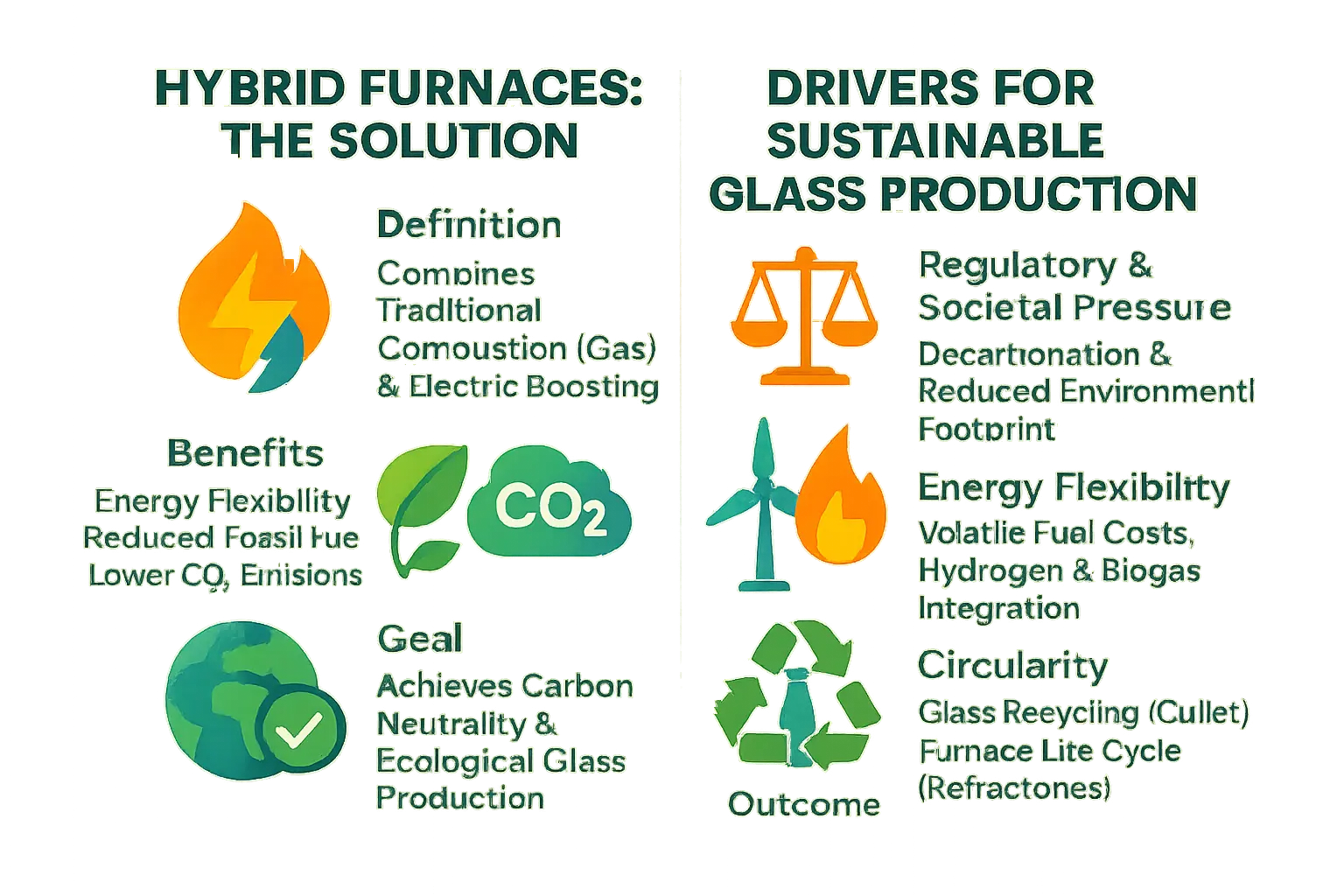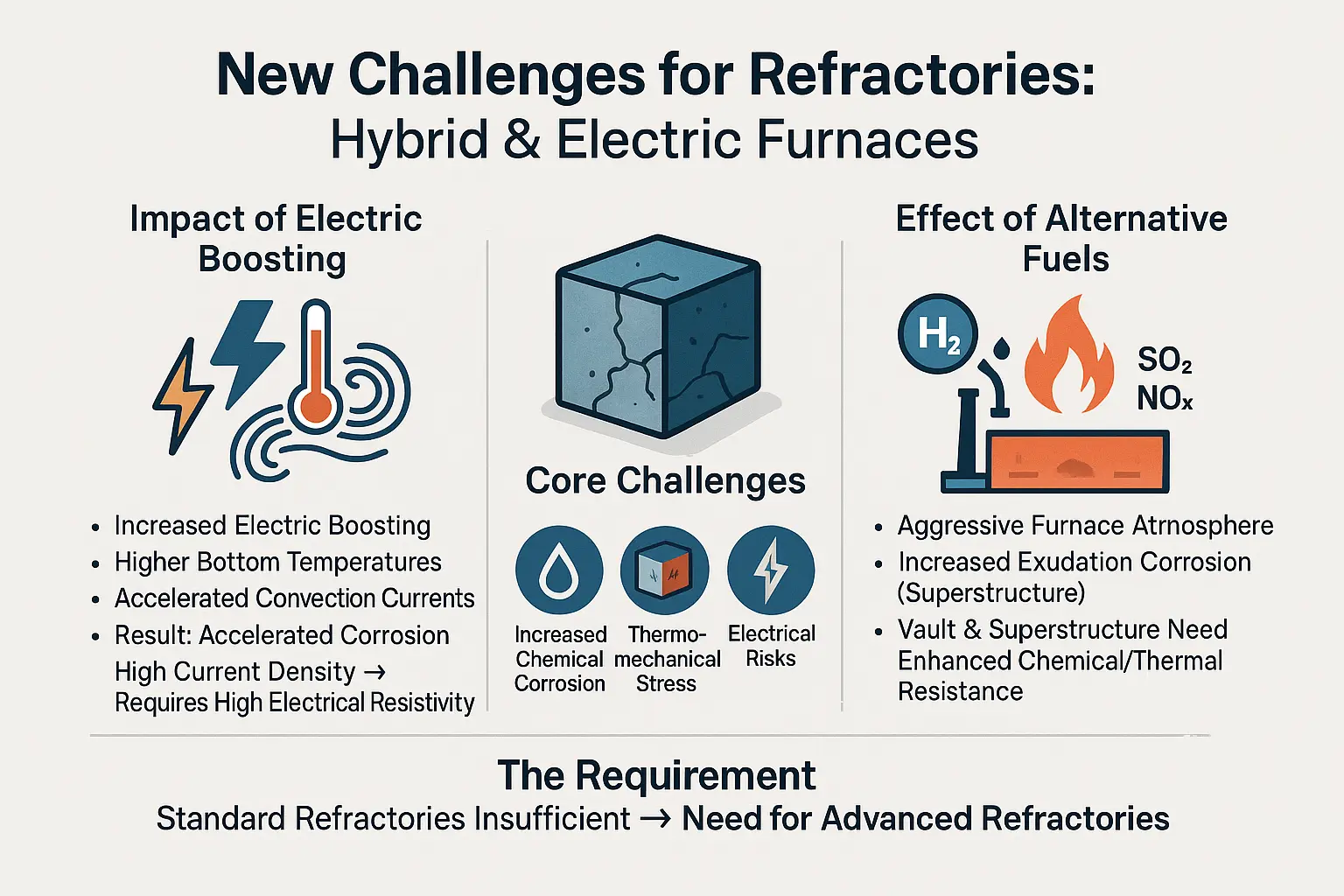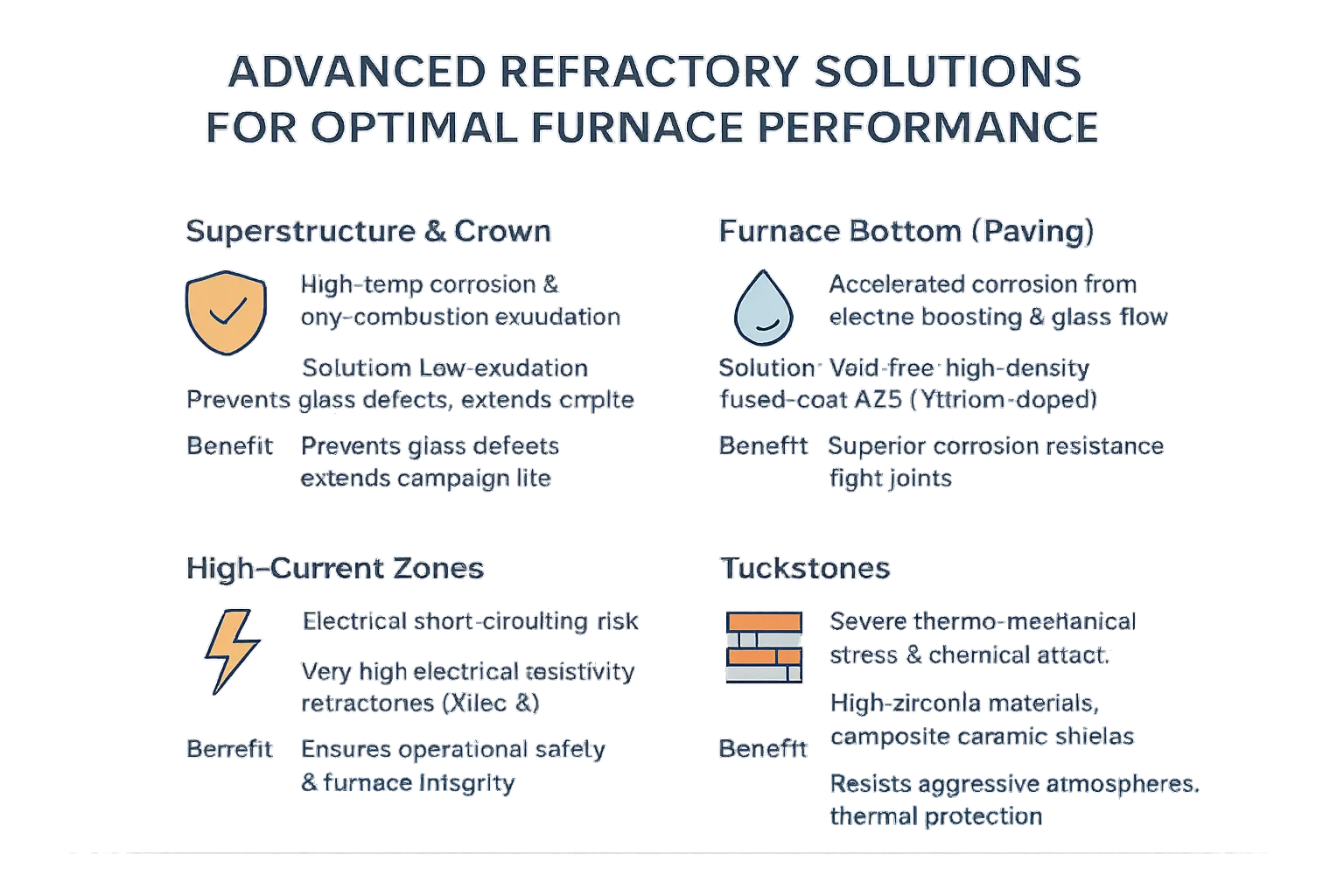Are your hybrid furnaces struggling to meet carbon neutrality targets while maintaining production efficiency? As glassmakers adopt electric boosting and hydrogen-compatible systems, advanced refractories hybrid furnaces confront extreme thermal gradients, aggressive chemical environments from oxy-combustion, and electrical conductivity risks that jeopardize both output quality and furnace integrity. Discover how next-gen materials like low-exudation AZS (Alumina-Zirconia-Silica), yttrium-doped fused-cast solutions for furnace bottoms, and ultra-high-resistivity ceramics like Xilec 9 are transforming performance—extending campaign life by 30%+, reducing energy losses through superior insulation, and enabling seamless transitions to low-carbon energy mixes without sacrificing operational flexibility or glass purity.
- The glass industry’s shift towards carbon neutrality and hybrid furnaces
- New challenges for refractories in hybrid and electric furnaces
- Advanced refractory solutions for optimal furnace performance
- The economic and operational case for high-performance refractories
- Embracing circularity and innovation in refractory technology
- Partnering For A Greener Future In Glass Manufacturing
The glass industry’s shift towards carbon neutrality and hybrid furnaces

Hybrid furnaces combine gas combustion with electric boosting to decarbonize glass production. This dual-energy approach reduces fossil fuel reliance while maintaining 1,400°C temperatures. By integrating renewable electricity (up to 80% of input), systems cut CO₂ emissions by 60% in direct operations, aligning with climate goals like the Paris Agreement.
What are hybrid furnaces and why are they essential?
Hybrid furnaces merge gas and electric energy for optimized efficiency. Electric boosting enables precise thermal control, minimizing waste. For example, Libbey Glass cut direct CO₂ emissions by 60% using hybrid technology. This isn’t an upgrade—it’s a strategic necessity. The design’s adaptability to green hydrogen ensures long-term compliance as industries pivot toward carbon neutrality.
The key drivers for sustainable glass production
- Regulatory and social pressure: With 22 million tons of annual CO₂ emissions in Europe, hybrid furnaces align with EU and US policies like the Carbon Border Adjustment Mechanism and Inflation Reduction Act.
- Energy flexibility: Hybrid systems adapt to volatile prices and alternatives like hydrogen. Air Liquide’s 2024 trials replaced 50% of natural gas with hydrogen in hybrid designs.
- Circularity: Advanced refractories (e.g., yttrium-doped materials) extend furnace life and enable safer recycling, supporting circular economy goals.
Refractories must withstand corrosion, thermal stress, and electrical currents. Innovations like Saint-Gobain’s Xilec 9 ceramics balance durability with sustainability. As hybrid furnaces evolve, material science remains pivotal for energy efficiency and global compliance with sustainability mandates.

New challenges for refractories in hybrid and electric furnaces
The impact of increased electric boosting
Electric boosting creates localized “hot zones” through Joule heating. Submerged electrodes operating at 100+ kW/m³ power density generate intense thermal gradients that accelerate corrosion. Refractories must withstand 9×10⁴ Ω·cm resistivity requirements while resisting glass infiltration from enhanced convection currents. The Marangoni effect becomes critical – metal contaminants create triphase interfaces between metal, glass, and refractory causing micro-channel drilling that reduces lifespan by 40%.
The effect of alternative fuels like hydrogen
Hydrogen combustion increases water vapor content 400% versus natural gas, forming corrosive alkali hydroxides and borates. Thermodynamic modeling (FactSage) shows these vapors create low-melting eutectics that penetrate refractory microstructures. Oxy-combustion systems amplify exudation corrosion by 40% through 20% higher peak temperatures. Saint-Gobain’s ER 1851 Lowex AZS resists alkali penetration via controlled crystallization, maintaining structural integrity beyond 30,000 operational hours under hydrogen cycles while reducing exudation by 30%.
Managing thermal stress and chemical corrosion
Hybrid furnace environments create a perfect storm of stresses:
- Chemical corrosion from 1,600°C+ temperatures and aggressive vapor species
- Thermo-mechanical stress from 200°C+ temperature gradients
- Electrical risks from 10⁴ A/m² current densities
Standard refractories fail within 12-18 months. Yttrium-doped AZS (ER 2010 RIC) extends service life 2.5× through microstructural reinforcement that prevents glass infiltration. Composite ceramic shields reduce thermal shock risks for zirconia tuckstones by 60%. Innovations like HYBRID-bonded castables demonstrate 40% faster heating cycles while maintaining 1,800°C thermal stability, addressing both productivity and sustainability goals through reduced energy consumption.

Advanced refractory solutions for optimal furnace performance
High-performance materials for the superstructure and crown
Hybrid furnaces face unique challenges from oxy-combustion and enhanced insulation, causing increased exudation and corrosion in superstructures. Traditional materials struggle to maintain integrity under these conditions, leading to premature campaign failures and production inconsistencies.
Low-exudation fused-cast AZS (Alumina-Zirconia-Silica) refractories offer a breakthrough solution. These materials demonstrate superior resistance to glass melt attack while minimizing defects in final products. For critical crown zones, high-alumina refractories provide exceptional creep resistance at elevated temperatures, maintaining structural stability beyond 1600°C operating conditions through optimized microstructure engineering.
AZS (Alumina-Zirconia-Silica) refractories combine optimized ZrO2 content with advanced casting techniques. When paired with high-alumina refractories, they create multi-layer systems that maintain structural integrity even under extreme thermal cycling. This synergy directly supports sustainability goals by reducing material consumption through extended campaign durations.
Specialized solutions for the furnace bottom and contact zones
Electric boosting technology creates intense corrosion risks at furnace bottoms through localized overheating and accelerated glass flow. Conventional materials fail to withstand these dynamic stresses, particularly in high-current density areas where thermal gradients can exceed 500°C per hour.
Void-free fused-cast AZS solutions like yttrium-doped ER 2010 RIC represent a quantum leap in performance. These materials achieve 99.8% density through advanced casting techniques, eliminating micro-crack formation. The yttrium additive (3-5%) stabilizes zirconia phase transitions, reducing thermal expansion hysteresis by 200-300% during temperature cycling. This innovation directly contributes to energy efficiency through extended maintenance intervals.
| Furnace Zone | Primary Challenge | Advanced Refractory Solution | Key Benefit |
|---|---|---|---|
| Superstructure & Crown | High-temperature corrosion, exudation from oxy-combustion | Low-exudation fused-cast AZS, High-alumina/zirconia fused-cast | Prevents glass defects, extends campaign life |
| Furnace Bottom (Paving) | Accelerated corrosion from electric boosting and glass flow | Void-free, high-density fused-cast AZS (e.g., Yttrium-doped) | Superior corrosion resistance, tight joints |
| High-Current Zones | Electrical short-circuiting risk | Very high electrical resistivity refractories (e.g., Xilec 9) | Ensures operational safety and furnace integrity |
| Tuckstones | Severe thermo-mechanical stress and chemical attack | High-zirconia materials, composite ceramic shields | Resists aggressive atmospheres, provides thermal protection |
Protecting critical areas: tuckstones and soldier blocks
Tuckstone zones experience combined mechanical stress and chemical attack due to their transitional position. Standard materials suffer accelerated wear from thermal gradients and aggressive glass components.
High-zirconia tuckstone compositions (60%+ ZrO2) with composite ceramic shields create multi-layer protection systems. These materials maintain structural integrity while resisting alkali vapor attack and thermal shock from frequent temperature fluctuations. The composite technology enables precise thermal expansion matching with adjacent components.
Soldier blocks require reinforced lower sections to combat heat accumulation. Advanced solutions incorporate gradient material compositions that increase thermal conductivity at contact surfaces while maintaining mechanical strength in upper zones. This tailored approach prevents thermal degradation while optimizing energy distribution efficiency in hybrid furnace environments.
The economic and operational case for high-performance refractories
Beyond initial cost: analyzing total cost of ownership (TCO)
The Total Cost of Ownership (TCO) for advanced refractories extends beyond upfront costs. While high-performance materials like low-exudation AZS (Alumina-Zirconia-Silica) or high-alumina electrofused blocks require higher initial investment, their long-term benefits outweigh these costs. TCO includes energy consumption, maintenance frequency, downtime losses, and furnace lifespan. Advanced insulating refractories reduce heat loss by up to 23%, lowering energy bills. Their resistance to corrosion and thermal shock minimizes unplanned shutdowns, which can cost industries millions annually. For example, electrofused zirconia-rich tuckstones paired with composite ceramic shields extend furnace campaigns, reducing rebuild frequency. By prioritizing TCO over purchase price, manufacturers unlock savings across operations.
Maximizing return on investment (ROI) through furnace longevity
ROI hinges on furnace longevity. High-performance refractories, such as yttrium-doped AZS (ER 2010 RIC), resist erosion and maintain structural integrity at temperatures exceeding 1,500°C. This durability extends furnace life by 30–50%, slashing reconstruction costs. For instance, hybrid furnaces using advanced refractories with ERSOL SL safety layers experience fewer joint failures, enabling uninterrupted production cycles. Targeted repair services, like predictive maintenance powered by real-time sensor data, further delay full rebuilds. A Saint-Gobain case study showed that optimized refractory linings reduced annual downtime by 20%, directly boosting annual output and profitability. ROI is amplified when paired with energy-efficient oxy-fuel combustion systems, which rely on refractories to withstand aggressive thermal and chemical stress.
Enhancing operational flexibility and glass quality
Advanced refractories deliver benefits beyond cost savings:
- Improved glass quality: Low-exudation materials like ER 1851 Lowex minimize inclusions and cords, critical for pharmaceutical and optical glass applications.
- Operational flexibility: Electrofused alumina-zirconia solutions enable stable operation across variable energy mixes (hydrogen, electric boosting), adapting to fluctuating fuel prices.
- Energy efficiency: Microporous insulation panels cut heat loss by 15–20%, aligning with net-zero targets. Saint-Gobain’s Xilec 9 refractories, with high electrical resistivity, optimize electric boosting efficiency in hybrid furnaces.
These advantages position advanced refractories as a strategic lever for sustainable glass production, reducing both carbon footprints and operational volatility.
Embracing circularity and innovation in refractory technology
The role of circular economy: recycling and revalorization
Refractory materials drive industrial sustainability by enabling circular practices. Traditional magnesia-chrome bricks, linked to toxic hexavalent chromium (Cr⁶⁺), are being replaced by chrome-free U1 refractories (MgO-Al₂O₃) cured at 200°C. This cuts CO₂ emissions by 357 kg/ton and avoids high-temperature firing. Recycling spent refractories in steel and glass industries reduces landfill waste and raw material extraction. However, hazardous residues like lead or nickel require safe disposal. Companies using secondary raw materials gain competitive edges while meeting environmental standards.
The development of eco-friendly refractory compositions
Modern refractories prioritize eco-design. Chrome-free spinel-periclase-zirconia (15% ZrO₂) blends offer thermal shock resistance without toxic byproducts. U1 refractories achieve lower porosity than MgO-Cr₂O₃ bricks, enhancing durability in harsh environments. Additives improve mechanical strength, while low-temperature curing (≤500°C) slashes energy use. These innovations align with decarbonization goals, proving sustainability and performance can coexist in refractory design.
Next-generation technologies for installation and monitoring
Innovations extend to installation methods and digital tools. HYBRID sol-gel bonded castables (e.g., REFRACAST® Hybrid F-60 AR/R) enable rapid heating, reducing shutdown times by 30-50%. Calcium-free formulations boost mechanical strength—up to 5x higher cold crushing strength versus conventional castables. Real-time sensors and CFD simulations optimize performance. For example, predictive maintenance systems use infrared and fiber-optic sensors to prevent failures in oxy-fuel furnaces. Xilec 9 electrofused materials, with high electrical resistivity, enhance durability in electric-boosted hybrid furnaces. These advancements cut downtime, lower energy use, and support the glass industry’s shift to hydrogen and biogas, merging material science with digitalization for greener operations.
Partnering For A Greener Future In Glass Manufacturing
Advanced refractories are no longer optional in hybrid furnaces—they are the linchpin of sustainable glass production. By enhancing energy efficiency and durability, these materials directly address carbon neutrality goals while reducing resource consumption.
Investing in high-performance refractories like low-exudation AZS or yttrium-doped variants isn’t just a cost—it’s a strategic move. These materials extend furnace lifespans, minimize downtime, and cut energy use by withstanding extreme thermal stresses and corrosive atmospheres from hydrogen or oxy-fuel combustion.
Yet material selection demands precision. The interplay of thermal cycling, alkali vapors, and chemical reactions requires tailored solutions. Custom refractory engineering ensures optimal corrosion resistance, thermal stability, and compatibility with evolving hybrid furnace designs.
A global partner in custom refractory engineering becomes critical. Expertise in material science, predictive modeling, and real-time monitoring transforms challenges into opportunities—like deploying electrofused alumina-zirconia-silica (AZS) systems that reduce defects by 30% while supporting circularity through recyclable components.
As the glass industry navigates decarbonization, the right refractory strategy isn’t just about surviving—it’s about pioneering a future where sustainability and performance aren’t competing priorities. MXS Refractories stands ready to bridge that gap with independent expertise and innovation.
The shift to hybrid furnaces drives carbon neutrality in glassmaking, requiring advanced refractories for thermal, chemical, and electrical resilience. Integrating high-performance materials and circularity (recycling, eco-friendly compositions) enables sustainable solutions. Partnering with experts in tailored refractory engineering ensures resilience and environmental alignment, driving a greener glass industry.
